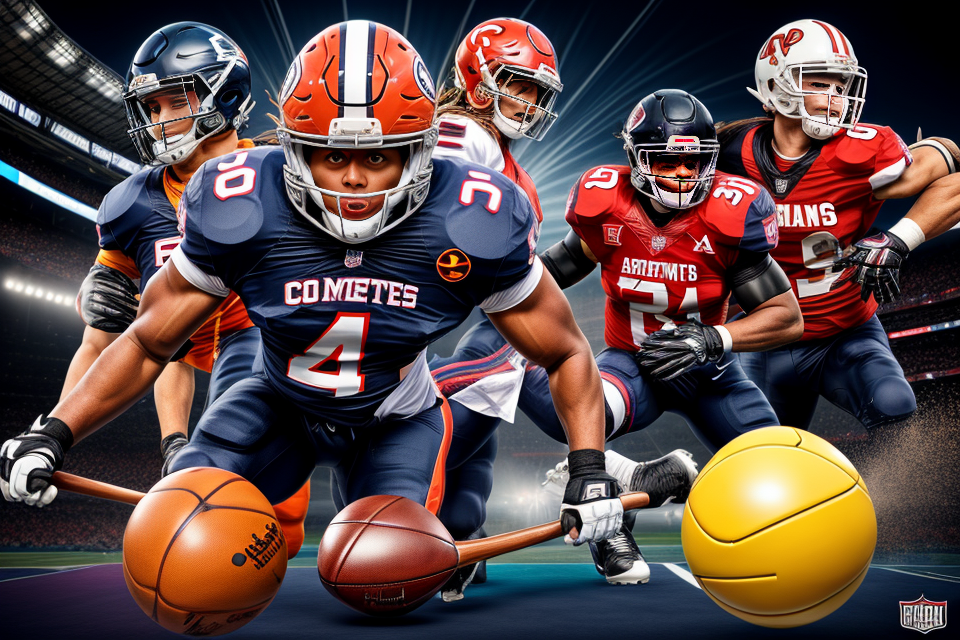
Uniforms, a common sight in schools, workplaces, and sports teams, have been a topic of debate for decades. Some argue that they promote a sense of unity and belonging, while others claim that they stifle individuality and creativity. In this article, we will explore the pros and cons of wearing uniforms, and try to answer the question: do uniforms enhance or hinder performance? From a strict dress code to a casual yet unified look, we will examine the impact of uniforms on personal expression, professionalism, and overall productivity. So, let’s dive in and see which side of the debate you’ll fall on.
The relationship between uniforms and performance is a topic of ongoing debate. Some argue that uniforms can enhance performance by creating a sense of unity and team identity, while others believe that they can hinder performance by limiting mobility and causing discomfort. In reality, the impact of uniforms on performance is likely to be context-dependent and varied. For example, in sports, uniforms may provide a sense of belonging and motivation, leading to improved performance, while in certain work environments, uniforms may impede movement and cause distractions, negatively impacting performance. Ultimately, the effectiveness of uniforms in enhancing or hindering performance depends on factors such as design, fit, and the specific requirements of the task at hand.
The Pros and Cons of Uniforms in the Workplace
Benefits of Uniforms
One of the main advantages of uniforms in the workplace is improved professionalism. When employees wear uniforms, they present a more polished and put-together appearance, which can enhance the reputation of the company. Uniforms can also help to establish a more formal and professional atmosphere, which can promote a sense of professionalism among employees.
In addition to enhancing professionalism, uniforms can also increase safety in the workplace. Uniforms can be designed to meet specific safety standards, such as providing protection from hazardous materials or increasing visibility in low-light conditions. This can help to reduce the risk of accidents and injuries on the job.
Another benefit of uniforms is that they can enhance the brand identity of a company. Uniforms can be designed to include the company logo or other branding elements, which can help to create a consistent and recognizable image for the company. This can be especially important for businesses that rely on customer recognition and loyalty, such as retail stores or restaurants.
Overall, the benefits of uniforms in the workplace can be significant, including improved professionalism, increased safety, and enhanced brand identity. However, it is important to carefully consider the specific needs and goals of the company when implementing a uniform policy, in order to ensure that the benefits are maximized and any potential drawbacks are minimized.
Drawbacks of Uniforms
Reduced Individuality
One of the most significant drawbacks of uniforms in the workplace is the reduced individuality. Employees often feel that they lose a part of their identity when they have to wear a uniform. This can lead to a sense of uniformity and lack of diversity among employees, which can be detrimental to a company’s culture. Moreover, uniforms can often be restrictive, limiting the ability of employees to express themselves through their clothing choices.
Potential for Uniform Fatigue
Another drawback of uniforms is the potential for uniform fatigue. Wearing the same outfit every day can become monotonous and boring, leading to a lack of motivation and enthusiasm among employees. This can affect their performance and productivity, as they may feel uninspired and unengaged in their work.
Additional Costs
Uniforms can also be expensive, both for the employer and the employee. Employers may have to spend a significant amount of money purchasing uniforms for their employees, which can be a significant financial burden. Additionally, employees may have to pay for the upkeep and maintenance of their uniforms, which can be costly over time. This can create additional stress and financial burden for both parties.
Factors Affecting the Effectiveness of Uniforms
Choice of Uniform Design
Appropriate Fabric
The choice of fabric for a uniform is crucial in determining its effectiveness. The fabric should be durable, easy to maintain, and suitable for the intended purpose. For instance, athletes require uniforms made of moisture-wicking materials that can keep them dry and comfortable during intense physical activity. In contrast, military personnel need uniforms made of sturdy materials that can withstand harsh weather conditions and protect them from potential hazards.
Comfortable Fit
The fit of a uniform is also essential in enhancing performance. A well-fitting uniform should be comfortable and allow for unrestricted movement. A tight-fitting uniform can be distracting and uncomfortable, leading to a decrease in performance. On the other hand, a loose-fitting uniform can get in the way and hinder movement, causing discomfort and affecting performance negatively.
Functional Features
The design of a uniform should incorporate functional features that enhance performance. For instance, a uniform for a sporting activity should have features such as pockets for storing equipment, zippers for ventilation, and reflective materials for visibility in low-light conditions. Similarly, a military uniform should have features such as cargo pockets for carrying essential equipment, and camouflage patterns for blending into the environment. The inclusion of these functional features can improve performance by providing convenience and increasing efficiency.
Implementation and Enforcement
Consistency in Policy
- Establishing clear guidelines and regulations for uniform wear
- Ensuring that the policies are uniformly enforced across all levels of the organization
- Maintaining consistency in the design and materials used for the uniforms
Training on Proper Wear
- Providing comprehensive training to employees on how to properly wear the uniform
- Ensuring that the training is regular and ongoing
- Establishing a system for evaluating and correcting improper uniform wear
Consequences for Non-Compliance
- Establishing consequences for employees who fail to comply with the uniform policy
- Ensuring that the consequences are fair and consistently enforced
- Establishing a system for monitoring and reporting non-compliance
The Role of Culture and Industry
Different Industry Standards
In various industries, the use of uniforms serves different purposes. For instance, in the healthcare sector, uniforms help to identify medical personnel and enhance patient recognition. In contrast, uniforms in the food service industry are often used to maintain a clean and professional appearance. As a result, the design and purpose of uniforms may vary across industries, which can impact their effectiveness.
Cultural Norms and Values
Cultural norms and values can also influence the use of uniforms in the workplace. In some cultures, certain types of clothing may be considered inappropriate or taboo. Therefore, companies must consider cultural differences when designing their uniform policies. Additionally, some employees may have religious or personal beliefs that require them to wear specific attire. Accommodating these differences can be challenging but is essential for creating an inclusive work environment.
Accommodating Diversity
The use of uniforms in the workplace can sometimes be a source of conflict for employees who do not identify with the standardized dress code. Companies must be mindful of these concerns and make an effort to accommodate diverse preferences and needs. This may involve offering a range of uniform options or allowing employees to express their individuality through accessories or other means. By creating a more inclusive environment, companies can foster a sense of belonging and increase employee satisfaction.
The Impact of Uniforms on Employee Performance
Physical Comfort and Mobility
The physical comfort and mobility of a uniform play a crucial role in determining its impact on employee performance. The material, cut, ergonomic design, and allowance for personal equipment are all factors that contribute to an employee’s physical comfort and mobility while wearing the uniform.
- Material and Cut
The material and cut of a uniform can significantly affect an employee’s comfort level. For instance, if the material is too rough or scratchy, it can cause discomfort and irritation, which can distract employees from their work. Similarly, if the cut of the uniform is too tight or too loose, it can limit an employee’s mobility and make it difficult for them to perform their job duties.
- Ergonomic Design
An ergonomic design of a uniform can improve an employee’s physical comfort and mobility. An ergonomic design takes into account the specific movements and tasks required for a particular job, and the uniform is designed to allow for maximum mobility and ease of movement. For example, a chef’s uniform is designed to allow for easy movement and flexibility while cooking, with a relaxed fit and short sleeves to prevent the fabric from getting in the way.
- Allowance for Personal Equipment
The allowance for personal equipment in a uniform can also impact an employee’s physical comfort and mobility. If the uniform is designed with pockets and other features that allow for the storage of personal equipment, it can improve an employee’s comfort level and mobility. For example, a delivery driver’s uniform may have multiple pockets to accommodate the delivery packages, allowing the driver to move around more easily while making deliveries.
Overall, the physical comfort and mobility of a uniform can have a significant impact on employee performance. A well-designed uniform that takes into account the specific needs and movements required for a particular job can improve an employee’s comfort level and mobility, allowing them to perform their job duties more effectively.
Psychological Effects
Wearing a uniform can have significant psychological effects on employees, which can either enhance or hinder their performance.
Perception of Authority
Uniforms can create a perception of authority, which can lead to increased respect for the wearer. When employees wear a uniform, they are often seen as representatives of their organization, and this can lead to an increase in their perceived authority. This can be particularly beneficial in situations where employees need to take charge or make decisions.
Sense of Belonging
Uniforms can also create a sense of belonging among employees. When everyone is wearing the same uniform, it can create a sense of unity and teamwork. This can be particularly beneficial in customer-facing roles, where employees need to work together to provide a high level of service.
Self-Perception and Confidence
Finally, uniforms can affect an employee’s self-perception and confidence. When employees wear a uniform, they may feel more confident and professional. This can be particularly beneficial in roles where employees need to project confidence, such as in sales or management positions.
However, it is important to note that these psychological effects can be both positive and negative, depending on the context and the specific uniform being worn. For example, a uniform that is uncomfortable or ill-fitting may have a negative impact on an employee’s self-perception and confidence. Similarly, a uniform that is too formal or restrictive may make employees feel uncomfortable and hinder their ability to perform their job effectively.
Communication and Visibility
Clarity of Design
The clarity of design is a crucial factor in the impact of uniforms on employee performance. Uniforms that are designed with clear and consistent visual elements can improve communication and recognition among employees. This is particularly important in settings where employees work in teams or need to communicate quickly and efficiently. A well-designed uniform can help employees identify each other and facilitate communication, which can ultimately enhance performance.
Visibility Aids
Visibility aids are another important aspect of uniform design. Uniforms that incorporate reflective materials or high-visibility colors can help employees be more visible in low-light conditions or in environments where visibility is limited. This can be particularly important in settings such as construction sites, warehouses, or emergency services, where employees need to be able to see each other and their surroundings clearly. Visibility aids can help improve safety and reduce the risk of accidents, which can ultimately enhance performance.
Ease of Identification
The ease of identification is another important factor in the impact of uniforms on employee performance. Uniforms that are designed with clear and consistent visual elements can make it easier for employees to identify each other and their roles. This can be particularly important in settings where there are multiple teams or departments working together, or where employees need to be able to identify each other quickly and efficiently. Clear and consistent visual elements can help reduce confusion and improve communication, which can ultimately enhance performance.
Making the Right Decision: Tips for Implementing Uniform Policies
Assessing Business Needs
When implementing a uniform policy in the workplace, it is important to consider the specific needs of the business. Here are some factors to consider:
Functional Requirements
The first step in assessing business needs is to consider the functional requirements of the uniform. For example, if the business involves manual labor, the uniform should be comfortable and provide adequate protection against potential hazards. On the other hand, if the business involves customer-facing roles, the uniform should project a professional image and be easy to clean.
Brand Image
Uniforms can play a significant role in shaping the brand image of a business. The uniform should be designed to reflect the values and culture of the company, and should be consistent with the image that the business wants to project. For example, a uniform that is clean, well-pressed, and professionally designed can help to project a positive image of the business.
Health and Safety
Health and safety should also be a consideration when implementing a uniform policy. The uniform should be designed to ensure that employees are able to move freely and comfortably, and should not pose any safety hazards. In addition, the uniform should be easy to clean and maintain, to ensure that it remains hygienic and free from bacteria and other contaminants.
Overall, it is important to consider the specific needs of the business when implementing a uniform policy. By taking the time to assess these needs, businesses can ensure that their uniform policies are effective in enhancing performance and projecting a positive image.
Flexibility and Adaptability
- Adjusting Uniform Policies
When it comes to implementing uniform policies, it’s important to remember that one size doesn’t fit all. Different workplaces and industries have unique needs, and uniform policies should be tailored to meet those needs. For example, a construction site may require more protective gear than an office setting.
- Accommodating Individual Needs
In addition to accommodating the needs of different workplaces, it’s also important to consider the individual needs of employees. Some employees may have physical limitations that require accommodations, such as a uniform that is easier to move in or a modified fit. Others may have cultural or religious beliefs that require accommodations, such as a headscarf or beard.
It’s important to have an open dialogue with employees to understand their needs and make accommodations when possible. This can help ensure that everyone feels comfortable and confident in their uniform, which can ultimately lead to better performance.
- Regular Reviews and Updates
Uniform policies should be reviewed and updated regularly to ensure they are meeting the needs of the workplace and its employees. Changes in technology, safety standards, and industry trends may require adjustments to the uniform policy.
It’s also important to gather feedback from employees on a regular basis to ensure the policy is working well for them. This can help identify any issues or concerns and allow for adjustments to be made as needed.
Overall, flexibility and adaptability are key components of implementing effective uniform policies. By taking the time to understand the unique needs of the workplace and its employees, and by regularly reviewing and updating the policy, you can help ensure that uniforms enhance rather than hinder performance.
FAQs
1. What are the benefits of wearing uniforms?
Uniforms can provide several benefits for students and employees. For one, they promote a sense of unity and belonging, as everyone is dressed in the same way. This can help to create a positive school or work environment, where individuals feel a sense of pride in their institution. Additionally, uniforms can help to eliminate distractions related to clothing choices, such as fashion trends or inappropriate clothing. This can help individuals to focus more on their studies or work.
2. Are there any drawbacks to wearing uniforms?
While there are several benefits to wearing uniforms, there are also some potential drawbacks. For one, uniforms can be expensive, particularly for families with multiple children in school. Additionally, some individuals may feel that uniforms limit their ability to express their personal style or individuality. This can lead to feelings of frustration or resentment towards the uniform policy.
3. Can uniforms enhance performance?
There is some evidence to suggest that wearing uniforms can enhance performance, particularly in academic settings. When students are dressed in uniforms, they may feel more focused and committed to their studies. Additionally, uniforms can help to create a sense of professionalism and seriousness, which can be beneficial for students preparing for exams or other important events.
4. Can uniforms hinder performance?
While uniforms may enhance performance for some individuals, there is also evidence to suggest that they can hinder performance for others. For example, some students may feel uncomfortable or self-conscious in their uniforms, which can negatively impact their self-esteem and confidence. Additionally, uniforms may not be appropriate for certain activities or environments, such as sports or outdoor events, which can limit individuals’ ability to participate fully.
5. Are there any alternatives to wearing uniforms?
In some cases, there may be alternatives to wearing uniforms that can achieve similar benefits. For example, schools or workplaces may implement a dress code that prohibits certain types of clothing, such as revealing or inappropriate attire. Additionally, some institutions may allow students or employees to express their individuality through accessories or personal touches on their clothing, such as buttons or patches. These alternatives may be more appropriate for certain individuals or environments, and can help to strike a balance between the benefits and drawbacks of wearing uniforms.


